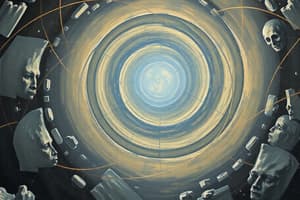Podcast
Questions and Answers
What is the ideal generated by a set in a ring?
What is the ideal generated by a set in a ring?
The ideal generated by a set $S$ in a ring $R$ is the smallest ideal that contains all elements of $S$. It is denoted as $\langle S \rangle$.
What is a quadratic integer ring?
What is a quadratic integer ring?
A quadratic integer ring is a ring that consists of all numbers of the form $a + b\sqrt{d}$, where $a$ and $b$ are integers and $d$ is a square-free integer.
Give an example of a non-commutative ring.
Give an example of a non-commutative ring.
An example of a non-commutative ring is the ring of 2x2 matrices with real entries under matrix addition and multiplication.
Explain what a trivial ring is and why it is called a zero divisor.
Explain what a trivial ring is and why it is called a zero divisor.
Define a maximal ideal in a ring.
Define a maximal ideal in a ring.
What are units in a ring?
What are units in a ring?
Why is the concept of zero divisor important in ring theory?
Why is the concept of zero divisor important in ring theory?
What is a zero divisor in a ring and how does it relate to the trivial ring?
What is a zero divisor in a ring and how does it relate to the trivial ring?
Flashcards are hidden until you start studying
Study Notes
Ring Theory Fundamentals
- The ideal generated by a set in a ring is the smallest ideal that contains the given set.
Quadratic Integer Rings
- A quadratic integer ring is a ring of the form ℤ[√d], where d is an integer, and is used to study quadratic fields.
Non-Commutative Rings
- The set of all 2x2 matrices with real coefficients is an example of a non-commutative ring, as the multiplication operation is not commutative.
Trivial Rings
- A trivial ring is a ring with only one element, typically denoted as {0}, and is called a zero divisor because it satisfies the equation a × 0 = 0 for all a in the ring.
- The trivial ring is called a zero divisor because any element multiplied by it results in 0.
Maximal Ideals
- A maximal ideal in a ring is an ideal that is not contained in any other ideal except for the ring itself.
Units in Rings
- Units in a ring are elements that have a multiplicative inverse, meaning that for a unit u, there exists an element v such that u × v = v × u = 1.
Zero Divisors
- A zero divisor in a ring is a non-zero element a that satisfies the equation a × b = 0 for some non-zero element b.
- The concept of zero divisors is important in ring theory because it helps to identify rings that are not integral domains, which are rings with no zero divisors except for 0.
- The trivial ring is a zero divisor because it satisfies the equation a × 0 = 0 for all a in the ring.
Studying That Suits You
Use AI to generate personalized quizzes and flashcards to suit your learning preferences.




